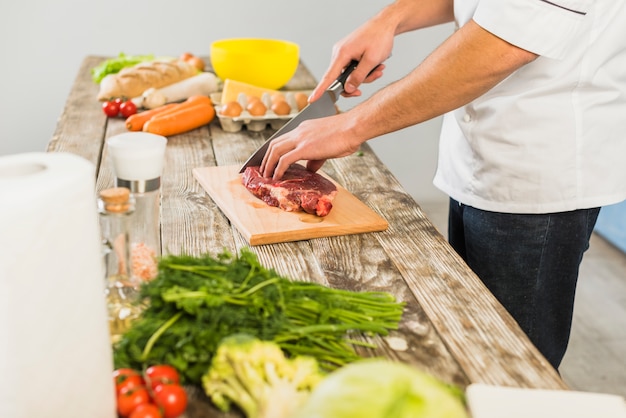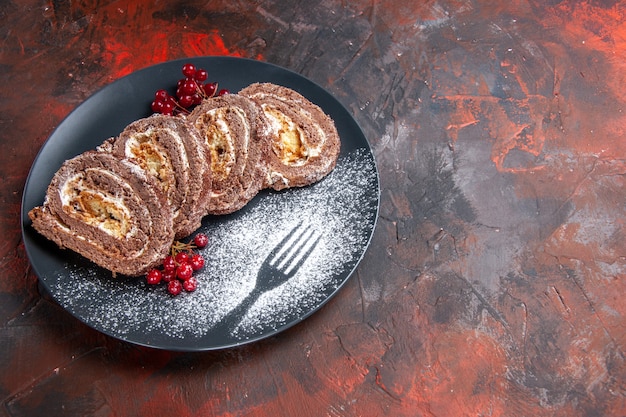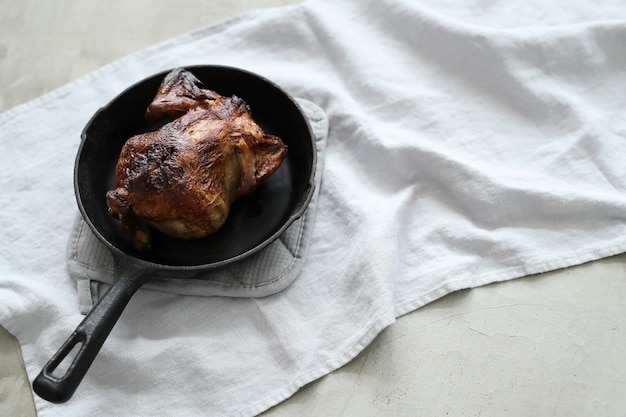pork loin. It's a culinary chameleon, isn't it? From succulent roasts to juicy chops, it's a versatile cut of meat that can be dressed up or down, and always delivers a delicious meal. But, let's be honest, cooking it to perfection can feel like a bit of a gamble. I've had my fair share of burnt, dry, or undercooked pork loin experiences, and I'm here to tell you, it's not fun!
That's why I'm sharing everything I've learned about nailing the perfect pork loin, from choosing the right cut to mastering those tricky cooking times. Buckle up, grab a cuppa, and let's embark on a culinary adventure together!
(Part 1) Choosing Your Pork Loin: The Foundation of Flavor

You can't build a great meal without a solid foundation, and that foundation, in this case, is your pork loin. There are a few different cuts available, each with its own unique personality and culinary strengths.
Personally, I'm a big fan of the boneless, centre-cut loin. It's a lean and tender cut, perfect for roasts, chops, and even grilling. It's generally the most versatile and cooks up beautifully. But, if you're feeling adventurous, a bone-in pork loin offers a slightly more robust flavour and can be a bit more forgiving if you're prone to overcooking.
Different Pork Loin Cuts: A Culinary Comparison
Let's break down the different cuts of pork loin to help you find the one that's right for your culinary vision:
- Boneless, Centre-Cut Loin: This is your trusty sidekick. It's the workhorse of pork loin cuts, perfect for both everyday meals and special occasions. It's typically available already rolled with netting, which helps it retain its shape during cooking. It's lean and tender, and cooks up quickly, making it a great option for busy weeknights.
- Bone-In Pork Loin: This cut has a more rustic appeal and a deeper, more complex flavour due to the bone. It's a great choice if you're looking for a show-stopping roast or if you prefer a more forgiving cut that can handle a little extra cooking time. It's also a good option for grilling, as the bone adds a nice char to the meat.
- pork tenderloin: This smaller, more delicate cut is a true culinary gem. It's incredibly tender and melts in your mouth. It's best suited for quick cooking methods like grilling or pan-frying, as it can become dry if overcooked. It's a real crowd-pleaser, perfect for small gatherings or special occasions.
The Pork Loin Pick: A Visual Guide
Once you've chosen your cut, take a close look at the meat itself. It should be a pale pink color with a good amount of marbling. The fat should be firm and white, not yellowish. This indicates fresh, high-quality meat. If the pork seems dry or has an unpleasant smell, it's best to steer clear – it's probably not at its freshest.
(Part 2) Preparing Your Pork Loin: Laying the Groundwork for Deliciousness

Okay, you've got your pork loin. Now it's time to get your hands dirty and prep it for cooking. This isn't about complicated techniques – just a few simple steps that make a world of difference in the final flavor.
Seasoning Your Pork Loin: The Art of Flavor Enhancement
I'm a firm believer in the power of simple seasoning. Salt and pepper, my friends, are the ultimate duo, but don't be afraid to experiment! You can create flavour profiles that are as adventurous as your culinary spirit. Here are a few of my go-to combinations:
- Rosemary and Garlic: A classic pairing that adds a herbaceous depth and a touch of warmth.
- Thyme and Sage: This combination is perfect for creating a savory, earthy flavor profile.
- Paprika and Cumin: A blend that brings a touch of warmth and spice to the pork loin.
- Mustard and Brown Sugar: A surprisingly delicious combination that adds a sweet and savory note to the pork.
Remember, a little goes a long way. Gently rub the seasoning into the pork loin, making sure to get every nook and cranny.
Additional Prep Tips: Elevate Your Pork Loin
Here are a few additional prep tips that can elevate your pork loin game:
- Tie it up! If you're roasting a large pork loin, tying it with kitchen twine will help it cook evenly and prevent it from losing its shape.
- Score the fat! If you've got a fattier cut, scoring the fat with a sharp knife will help the fat render during cooking, resulting in a juicier pork loin. Make shallow cuts across the fat, about ?? inch deep.
- Don't over-handle it! Overworking the meat can make it tough. Gently pat it dry with paper towels and resist the urge to fuss over it too much.
(Part 3) Cooking Your Pork Loin: oven roasting, the Classic Approach

Oven roasting is a timeless method for cooking pork loin, and it's surprisingly easy to master. The key is finding the perfect balance of temperature and cooking time to ensure a juicy, flavorful result.
Oven Roasting Instructions: A Step-by-Step Guide
Here's a step-by-step guide to ensure a perfectly roasted pork loin:
- Preheat your oven to 350 degrees fahrenheit (175 degrees Celsius). This ensures that the oven is hot enough to create a beautiful crust on the pork loin.
- Place the pork loin in a roasting pan and roast for about 15-20 minutes per pound. This is a general guideline, but the cooking time will vary depending on the size and thickness of your pork loin.
- Keep a close eye on the internal temperature using a meat thermometer. Insert the thermometer into the thickest part of the loin, making sure it's not touching any bone. The safe internal temperature for pork loin is 145 degrees Fahrenheit (63 degrees Celsius). For a juicier loin, aim for 150 degrees Fahrenheit (66 degrees Celsius).
- Let the pork loin rest for 10-15 minutes before carving. This allows the juices to redistribute throughout the meat, resulting in a more tender and flavorful loin.
Tips for Oven Roasting: From Novice to Master
Here are a few tips to take your oven-roasted pork loin from good to great:
- Add liquid to the pan. A little bit of liquid, like chicken broth or apple cider, helps keep the pork loin moist. Add about ?? cup to the bottom of the roasting pan.
- Baste it! Basting the pork loin with the pan juices every 30 minutes will keep it moist and flavorful. Use a brush to generously apply the juices.
- Don't overcrowd the pan. Give the pork loin some breathing room to cook evenly. If you're cooking a large roast, you may need to use a larger roasting pan.
(Part 4) Cooking Your Pork Loin: Grilling, a Smoky Symphony of Flavor
Grilling brings a smoky depth of flavor to pork loin, and it's a great way to enjoy the outdoors. But remember, a clean, well-heated grill is key to achieving that perfect char and delicious smoky aroma.
Grilling Instructions: From Charcoal to Gas
- Preheat your grill to medium-high heat. Whether you're using a charcoal or gas grill, make sure the grill grates are hot enough to create a beautiful sear on the pork loin.
- Lightly oil the grill grates to prevent sticking. This will help to keep the pork loin from sticking to the grill grates and will ensure even browning.
- Place the pork loin on the grill and cook for about 5-7 minutes per side, or until it's nicely browned. You'll know it's ready when you see those enticing grill marks.
- Reduce the heat to medium-low, cover the grill, and continue cooking for another 15-20 minutes, or until the internal temperature reaches 145 degrees Fahrenheit (63 degrees Celsius). This ensures that the pork loin is cooked through while maintaining its juicy texture.
- Let the pork loin rest for 10-15 minutes before carving. This allows the juices to redistribute and creates a more tender and flavorful result.
Tips for Grilling: A Master Griller's Insights
Here are a few tips to help you become a grilling master:
- Use a meat thermometer. This is essential for ensuring the pork loin is cooked through and reaches the safe internal temperature.
- Don't overcook it! grilled pork loin is best cooked medium to medium-well, as overcooking can make it dry and tough.
- Keep it moving! Rotate the pork loin every 5-7 minutes to ensure even cooking.
(Part 5) Cooking Your Pork Loin: Pan-Frying, a Quick and Easy Feast
Pan-frying is a quick and easy way to cook pork loin, perfect for smaller cuts or individual pork chops. It's a great option for busy weeknights when you want a delicious meal without a lot of fuss.
Pan-Frying Instructions: A Simple Guide
- Heat a heavy-bottomed pan over medium-high heat. Use a pan that can distribute heat evenly for consistent cooking.
- Add a tablespoon of oil to the pan. Choose an oil with a high smoke point, like vegetable oil or canola oil.
- Once the oil is shimmering, add the pork loin to the pan. Don't overcrowd the pan; cook the pork loin in batches if necessary.
- Cook for 3-5 minutes per side, or until nicely browned. You'll know it's ready when you see a beautiful crust forming on the pork loin.
- Reduce the heat to medium-low, cover the pan, and continue cooking for another 5-7 minutes, or until the internal temperature reaches 145 degrees Fahrenheit (63 degrees Celsius). This will ensure the pork loin is cooked through while retaining its juiciness.
- Remove the pork loin from the pan and let it rest for 5-10 minutes before carving. This will allow the juices to redistribute and enhance the flavor and tenderness.
Tips for Pan-Frying: From Beginner to Pro
Here are a few tips to help you master the art of pan-frying pork loin:
- Don't overcrowd the pan. Cook the pork loin in batches if needed to prevent overcrowding.
- Season it liberally. The pork loin will absorb the flavors of the seasoning, so don't be shy with it!
- Don't overcook it! Pan-fried pork loin is best cooked medium to medium-well. Overcooking will lead to dryness and toughness.
(Part 6) Checking for Doneness: The Art of the Meat Thermometer
We've talked about cooking methods, but how do you know when your pork loin is truly done? The most reliable method, and the one I always use, is a meat thermometer.
Using a Meat Thermometer: A Culinary Must-Have
A meat thermometer is a culinary hero. It takes the guesswork out of cooking, ensuring that your pork loin is cooked safely and to your desired level of doneness.
- Insert the thermometer into the thickest part of the loin. Make sure it's not touching any bone.
- The safe internal temperature for pork loin is 145 degrees Fahrenheit (63 degrees Celsius). This ensures that any harmful bacteria is destroyed.
- For a juicier pork loin, aim for 150 degrees Fahrenheit (66 degrees Celsius). This will give you a slightly more pink and tender loin.
(Part 7) Resting Your Pork Loin: A Culinary Pause for Perfection
Once your pork loin is cooked to perfection, it's time for a well-deserved rest. This critical step allows the juices to redistribute throughout the meat, resulting in a juicier, more tender loin.
Resting Tips: Unlock Culinary Magic
- Cover the pork loin with foil. This will help keep it warm and moist while it rests.
- Let it rest on a cutting board. This will allow the juices to drain away from the meat.
- Be patient! Don't be tempted to cut into the pork loin too soon. Give it time to rest, and you'll be rewarded with a much better-tasting loin.
(Part 8) Serving Your Pork Loin: A Culinary Symphony of Flavor
Congratulations! Your pork loin is cooked and rested, ready to take center stage. Now it's time to unleash your creativity and create a culinary masterpiece.
Pork Loin Serving Ideas: Unleash Your Culinary Creativity
Here are a few ideas to get your culinary juices flowing:
- Slice it up! The classic way to serve pork loin is sliced, either as a roast or as chops.
- Serve it with sides. Pork loin goes great with a variety of sides, like mashed potatoes, roasted vegetables, a creamy risotto, or a refreshing salad.
- Make a sandwich! leftover pork loin can be used to make delicious sandwiches. Try it with some mustard and pickles, or get creative with your favorite toppings.
- Add it to a salad. Sliced pork loin can add a protein boost to salads.
(Part 9) Storing Your Leftover Pork Loin: Savoring Every Last Bite
Leftover pork loin is a culinary treasure! It can be transformed into a variety of delicious dishes. If you have any leftover pork loin, store it in the refrigerator for up to 3-4 days.
Storing Tips: Preserve the Flavor
- Let it cool completely before storing. This will help prevent bacterial growth and maintain the quality of the meat.
- Store it in an airtight container. This will keep the pork loin fresh and prevent it from drying out.
- Use it within 3-4 days. After that, the pork loin will start to lose its quality.
FAQs: Answering Your Pork Loin Questions
I've covered a lot of ground, but I know you've probably got more questions. Let's tackle some of the most common ones.
1. Can I freeze pork loin?
Absolutely! Freezing pork loin is a great way to extend its shelf life. Just wrap it tightly in plastic wrap or aluminum foil, then place it in a freezer-safe bag. It will keep in the freezer for up to 2-3 months. Remember to thaw it in the refrigerator overnight before cooking.
2. What happens if I overcook pork loin?
overcooked pork loin can be dry and tough. It's best to err on the side of undercooking, as you can always cook it a little longer if needed. A meat thermometer is your best friend for avoiding overcooking. If it seems a bit dry, don't despair! Resting the pork loin for a longer period will help to redistribute the juices.
3. How do I know if my pork loin is done?
The most reliable way to tell if your pork loin is done is to use a meat thermometer. The safe internal temperature for pork loin is 145 degrees Fahrenheit (63 degrees Celsius). If you don't have a thermometer, you can check for doneness by pressing on the pork loin. If it's firm to the touch and the juices run clear, it's done.
4. What can I do with leftover pork loin?
Leftover pork loin is a culinary chameleon! You can slice it and add it to salads, sandwiches, or stir-fries. You can also dice it and use it in pasta dishes or soups. Let your creativity run wild!
5. What are some good seasonings for pork loin?
Salt and pepper are always a great starting point, but don't be afraid to get adventurous with herbs and spices. Some of my favourites include rosemary, garlic, thyme, sage, paprika, cumin, mustard, and brown sugar. Experiment and see what combinations you enjoy most!
There you have it! Now you're equipped with the knowledge to cook the perfect pork loin. Don't be afraid to experiment, and most importantly, enjoy the process! Happy cooking!
Everyone is watching

Prime Rib Roast Cooking Time Chart: Per Pound Guide
Cooking TipsPrime rib roast. Just the name conjures images of lavish dinners, crackling fires, and hearty laughter. It’s ...

How Long to Bake Potatoes in the Oven (Perfect Every Time)
Cooking TipsBaked potatoes are a staple in my kitchen. They're incredibly versatile, delicious, and surprisingly easy to m...

Perfect Rice Every Time: The Ultimate Guide to Cooking Rice
Cooking TipsAs a self-proclaimed foodie, I've always been a bit obsessed with rice. It's the foundation of countless cuisi...

The Ultimate Guide to Cooking Asparagus: Tips, Techniques, and Recipes
Cooking TipsAsparagus. The mere mention of this spring delicacy conjures up images of vibrant green spears, crisp and burs...

Ultimate Guide to Cooking the Perfect Thanksgiving Turkey
Cooking TipsThanksgiving. Just the word conjures up images of overflowing tables laden with delicious food, the scent of r...
